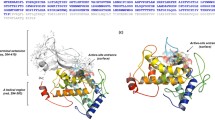Summary
The influence of cysteine on the oxidation of tyrosine, dopa, and monocysteinyldopas by mushroom tyrosinase was reexamined. During oxidation of tyrosine in the presence of cysteine the concentration of dopa increased slowly, whereas the concentration of cysteinyldopas increased more rapidly. When the concentration of cysteine decreased the cysteinyldopas were rapidly consumed and dopa concentrations increased sharply.
Experiments on the oxidation of dopa by tyrosinase in the presence of cysteine showed that this thiol does not inhibit the oxidation. Dopa concentrations decreased more rapidly in the presence of cysteine because cysteine addition to dopaquinone prevented reformation of dopa from dopaquinone.
Both 2-S-cysteinyldopa and 5-S-cysteinyldopa are substrates for tyrosinase. The oxidation of cysteinyldopas was inhibited at high cysteine concentrations. The greater part of 2,5-S,S-dicysteinyldopa formed during the oxidation of monocysteinyldopas in the presence of cysteine is derived from 5-S-cysteinyldopa, which is a better substrate for tyrosinase than 2-S-cysteinyldopa. The fact that cysteine binds more rapidly to 5-S-cysteinyldopaquinone than to 2-S-cysteinyldopaquinone further stresses the importance of 5-S-cysteinyldopa in the formation of 2,5-S,S-dicysteinyldopa.
Oxidation of dopa in the presence of cysteine and glutathione or methionine showed that glutathione is added to dopaquinone but less rapidly than cysteine. Methionine showed insignificant addition to dopaquinone.
When dopa or 5-OH-dopa is added to an incubate of cysteinyldopa and tyrosinase the oxidation of cysteinyldopa is accelerated owing to oxidation of cysteinyldopa by dopaquinone or 5-OH-dopaquinone.
Similar content being viewed by others
References
Agrup G, Falck B, Kennedy B-M, Rorsman H, Rosengren A-M, Rosengren E (1975) Formation of cysteinyldopa from glutathionedopa in melanoma. Acta Derm Venereol (Stockh) 55:1–3
Agrup G, Falck B, Rorsman H, Rosengren A-M, Rosengren E (1977) Glutathionedopa in malignant melanoma. Acta Derm Venereol (Stockh) 57:221–222
Agrup G, Hansson C, Rorsman H, Rosengren A-M, Rosengren E (1976) Mass spectrometric analysis of enzymatically synthetized cysteinyldopa isomers. Communications from the Department of Anatomy, University of Lund, Sweden, No 5
Aubert Ch, Rougé F, Galindo J-R, Hansson C, Rorsman H, Rosengren E (1980) Methionine and pigmentation. Abstracts, The XIth International Pigment Cell Conference, Sendai, Japan
Chen YM, Chavin W (1972) Effects of depigmentary agents and related compounds upon in vitro tyrosinase activity. In: Riley V (ed) Pigmentation. Its genesis and biologic control. Appleton-Century-Crofts Meredith, New York, pp 593–606
Frenk E, Pathak MA, Szabó G, Fitzpatrick TB (1968) Selective action of mercaptoethylamines on melanocytes in mammalian skin. Arch Dermatol 97:465–477
Halprin KM, Ohkawara A (1966) Glutathione and human pigmentation. Arch Dermatol 94:355–357
Hansson C, Agrup G, Rorsman H, Rosengren A-M, Rosengren E (1979) Analysis of cysteinyldopas, dopa, dopamine, noradrenaline and adrenaline in serum and urine using high-performance liquid chromatography and electrochemical detection. J Chromatogr 162:7–22
Hansson C, Rorsman H, Rosengren E (1980) 5-Hydroxydopa, a new compound in the Raper-Mason scheme of melanogenesis. Acta Derm Venereol (Stockh) 60:281–286
Hansson C, Rorsman H, Rosengren E (1980) 5-S-Cysteinyldopa as a substrate for tyrosinase. Acta Derm Venereol (Stockh.) 60:399–402
Ito S, Nicol JAC (1975) 2,5-S,S-Dicysteinyldopa: A new amino acid in the eye of the gar and its enzymic synthesis. Tetrahedron Lett 38:3287–3290
Ito S, Nicol JAC (1977) A new amino acid, 3-(2,5-SS-dicysteinyl-3,4-dihydroxyphenyl)alanine, from the Tapetum lucidum of the gar (Lepisosteidae) and its enzymic synthesis. Biochem J 161:499–507
Ito S, Prota G (1977) A facile one-step synthesis of cysteinyldopas using mushroom tyrosinase. Experientia 33:1118–1119
Ito S, Novellino E, Chioccara F, Misuraca G, Prota G (1980) Co-polymerization of dopa and cysteinyldopa in melanogenesis in vitro. Experientia 36:822–823
Lerner AB, Fitzpatrick TB, Calkins E, Summerson WH (1950) Mammalian tyrosinase. The relationship of copper to enzymatic activity. J Biol Chem 187:793–802
Prota G (1972) Structure and biogenesis of phaeomelanins. In: Riley V (ed) Pigmentation. Its genesis and biologic control. Appleton-Century-Crofts Meredith, New York, pp 615–630
Prota G, Crescenzi S, Misuraca G, Nicolaus RA (1970) New intermediates in phaeomelanogenesis in vitro. Experientia 26:1058–1059
Prota G, Rorsman H, Rosengren A-M, Rosengren E (1976) Phaeomelanic pigments from a human melanoma. Experientia 32:970–971
Prota G (1980) Recent advances in the chemistry of melanogenesis in mammals. J Invest Dermatol 75:122–127
Rorsman H, Rosengren A-M, Rosengren E (1973) Determination of 5-S-cysteinyldopa in melanomas with a fluorimetric method. Yale J Biol Med 46:516–522
Rorsman H, Agrup G, Hansson C, Rosengren A-M, Rosengren E (1979) Detection of phaeomelanins. In: Klaus SN (ed) Pigment cell, vol 4. Karger, Basel, pp 244–252
Saetre R, Rabenstein DL (1978) Determination of cysteine in plasma and urine and homocysteine in plasma by high-pressure liquid chromatography. Anal Biochem 90:684–692
Seiji M, Yoshida T, Itakura H, Irimajiri T (1969) Inhibition of melanin formation by sulfhydryl compounds. J Invest Dermatol 52:280–286
Author information
Authors and Affiliations
Rights and permissions
About this article
Cite this article
Agrup, G., Hansson, C., Rorsman, H. et al. The effect of cysteine on oxidation of tyrosine dopa, and cysteinyldopas. Arch Dermatol Res 272, 103–115 (1981). https://doi.org/10.1007/BF00510400
Received:
Issue Date:
DOI: https://doi.org/10.1007/BF00510400




